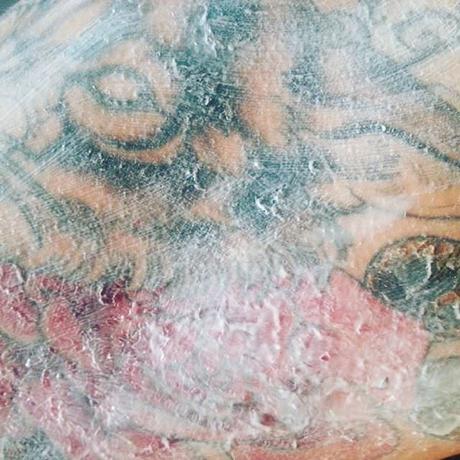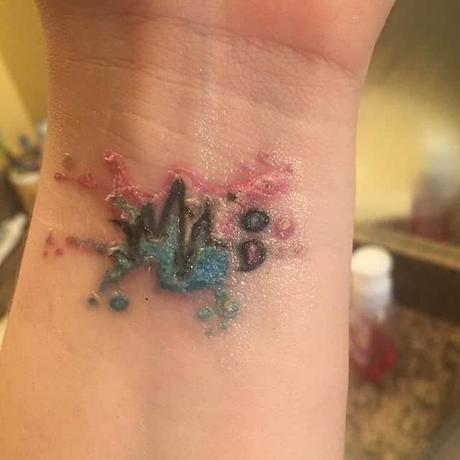It's sometimes hard to estimate how long a tattoo will take to heal, but there are many ways to prevent healing from becoming a drag. All of our tips and tricks below should help to ensure healing times are kept as short as possible.
We'll explain how long an average tattoo takes to heal, and the many factors that come into play when determining healing times.
How Long Does It Take For A Tattoo To Heal?
After getting a tattoo, the outer layer of skin will normally heal within 2 to 3 weeks. However, while it may look and feel completely healed, it can actually take as long as 6 months for the deeper layers of tattooed skin to truly heal.
The skin around larger tattoos can take longer to recover, and certain factors such as picking at the scabs, not moisturizing, forgetting to apply sunscreen, or using the wrong type of lotion may slow down the healing process.
While your tattoo should be looking great after the initial 2-3 weeks, it may appear slightly shiny and scaly for several more.
Tattoo Healing Stages
The visible part of your tattoo will slowly heal over four to six weeks. However, the deeper layers of skin will take up to a couple of months to heal completely.
1. Stage One (Days 1-6) - Redness, swelling, and oozing that slowly gets better each day. Scabbing begins to form during this stage.
2. Stage Two (Days 7-14) - Peeling and flaking begins, and this continues until all layers of dead skin and scabs have fallen away. This stage can be quite itchy.
3. Stage Three (Days 15-30) - The tattoo begins to look fully healed, but may appear slightly cloudy for another few weeks. Deeper layers of skin are still repairing, so you must continue to take care of your tattoo.
How To Reduce Tattoo Healing Times
There are many factors in play that can determine the times of your tattoo healing process. Take each of the below factors into consideration, and you'll have the best chance of healing your tattoo as quickly as possible.
Scabs and Skin Being Pulled off Prematurely
One of the most essential things to remember when your tattoo is healing is to NOT pick the scabs off, no matter how tempting. This also goes for pulling off pieces of peeling skin.
Heavy scabs that are not yet ready to fall off are still forming deep enough into your skin to affect the layers in which the tattoo ink has been set, meaning that pulling a scab off prematurely can pull ink away from the area, potentially leaving pits and colorless spots in your skin.

Pulling thick scabs away can delay healing times considerably, and will potentially cause your tattoo to require extra touchups from your artist if any color is lost.
The same goes for peeling skin. This stage of healing can be very uncomfortable, with large areas of half-dead skin hanging from your tattooed area and varying bouts of itching (dependant on factors such as skin dryness).

Read our great guide here on how to stop your tattoo itching.
Just remember that this stage only normally lasts for several days, so try and see it out by letting the skin fall off naturally without pulling it off. Peeling skin off that isn't yet ready to fall off can pull ink from the skin just like scabbing can.

Applying Aftercare Products
Although not necessary by any means, applying a good aftercare lotion helps to speed up healing by keeping your tattoo nourished and well-moisturized.
Don't overdo it, though. You should only need to apply lotion after each time you wash the area, so around 2-3 times per day depending on how clean you can keep your tattoo between washes, or whenever your tattoo looks/feels very dry.
What you must not do, though, is smother your tattoo in a thick layer of lotion. While the skin is healing, it needs to breathe, and a 1-inch thick block of tattoo cream isn't exactly going to help the process. This can delay healing and cause your tattoo to bubble up.

If you accidentally apply too motion lotion/ointment/cream, simply gently dab off any excess until there's only a very thin layer remaining on the tattoo.
As mentioned, lotions and ointments aren't required, but can definitely help towards speeding up the healing process and ensuring the tattoo looks clear and bright afterwards.
The best tattoo lotion I've ever personally used is a vegan-friendly aftercare product called After Inked Tattoo Aftercare Lotion. This stuff works amazingly well during the healing process; not only by keeping your tattoo really well hydrated, but also by soothing any annoying itching and irritation. When using it from the very start of the healing process, this lotion will help to decrease tattoo healing times, and work towards eliminating any lingering dryness and scabbing.
Submerging Your Tattoo in Water
Along with pulling off scabs, this is up there as one of the worst things you can do to your new tattoo. You mustn't submerge your tattoo in water for any length of time at all for the first few weeks. Take short showers once or twice a day, and avoid allowing any water to spray directly onto the tattooed area.

Going Out in the Sun
This can be a serious tattoo killer. Nothing is more harmful to your tattoo than the almighty big ball of fire - especially when the tattoo is fresh. Your skin will be extremely sensitive to UV rays during the first couple of weeks, and any sun exposure for more than a few minutes can cause skin irritation and burns; and trust me, sunburn on a new tattoo is not fun. Expect a large delay in healing if this happens to you.
Check out our post on how to have fun in the sun without worrying about damaging your tattoo.
Tattoo Location and Contact With Clothing
Depending on where on your body your new tattoo is, various materials are going to come into contact with, and rub against the tattooed area. Any prolonged or vigorous rubbing over recently tattooed skin is going to be detrimental to the healing process and will most likely prolong recovery somewhat.
It is not only the rubbing motion that can irritate a tattoo, but also the material itself. Recently tattooed skin is going to be much more prone to irritation, and you may find that certain materials (such a latex, for example) that do not normally cause irritation, can quite easily bring tattoos out in a bright rash if left in contact with the skin for any extended periods of time.
Tattoo Location and Skin Rubbing
In relation to the advice about avoiding prolonged clothing contact - it may also be advantageous in some instances to try to avoid contact with yourself (huh?)
There are many parts of your body that naturally rub against other parts all day long - think inner thighs, fingers, and under-arms. All of these places naturally rub against other body parts on a regular basis. This, just like clothing, can also cause irritation, and any skin-on-skin contact should be avoided as much as possible.
Obviously, I'm not telling you to wobble about in a squatting duck position to prevent your thighs from slapping together, but try and be as proactive as possible. If you know you're getting your tattoo done in an area that is likely to rub in your day-day activities, take 2 or 3 days off to rest, and let your tat heal irritation-free for a while before going back to your normal daily life.
Being tattooed in/over/around joints can also be a bit of a nuisance. Places like the wrist, inner elbow and neck are constantly on the move, meaning that when a tattooed area tries to scab over and grow new skin, these areas are constantly being broken down again due to the skin twisting, stretching and pulling.
Now, I'm not asking you to start straight-arming all of your drinks at the bar, but try and move your tattooed joints as little as possible. It's tough for a week or so, and joints do generally take longer to heal than other areas, this can't be helped, but try to keep movement as minimal as possible.
For example, if you've gotten the ditch (inner elbow) of your dominant arm recently covered, try brushing your teeth, combing your hair and doing 'other' (ahem) activities with your less dominant arm. Warning; doing some of these may be tougher than you think.
Whether the Tattoo is in Color or Black and Grey
It's well-understood that color tattoos do generally take longer to heal than B&G (black and grey) due to the contents of the ink. All colored inks contain very small amounts of metal that the human body finds hard to accept.

Some people react worse than others to these metals, and in some situations the body can actually push out some of the ink, increasing healing times and prompting a tattoo touch up from your artist.
Out of all the colors, red ink causes the most adverse reactions to healing by far. This is due to the makeup of the ink compared to most other common colors. Please bear this in mind, as if you are one of the unlucky people to have an unfortunate reaction to red ink, your tattoo may take a while longer to heal, and may even turn out a little patchy-looking due to your body trying to expel the unwanted ink components.
Your General Health and Immune System
You have to remember that no matter how popular and common tattoos are these days, they are still essentially large open wounds caused by trauma carried out over long lengths of time (having needles passed in and out of your skin thousands of times in a single sitting injecting a foreign substance into your body).
Therefore, as with all other types of damage your body goes through on a regular basis (cuts, scrapes and bruises), healing is going to be at its fastest when you're mentally and physically well-rested and properly nourished.
If you know you don't get your recommended amount of daily fruit and vegetables, it may definitely be worth supplementing with a good multivitamin to try and boost your body's healing properties as best as possible.
Please note that if you are currently unwell or have any ongoing health/medical conditions, your immune system is likely to be running lower than normal, and therefore your new tattoo may heal a little (or a lot) slower than what it would do with a full-strength immune system, depending on your condition.
I know this is the last thing you want to do if you're excited about getting your new tattoo, but if you're currently fighting a short-term illness (like a cold or flu), it is sometimes better to postpone your appointment and wait until the illness has passed. Not only will your tattoo likely heal faster/better, but you will also minimize the risk of passing your plague onto somebody else at the studio.
Working Out and Physical Jobs
It's not advisable to go to the gym or conduct any vigorous activity for at least a couple of days after getting a new tattoo. Your immune system will probably be slightly weakened, and overdoing it can add delays to healing. Gyms and many places of work can also be very dirty, so ensure your tattoo is covered well to minimize the risk of infection. Once home, clean your tattoo well.
Weightlifting and cardio can also cause your tattoo to rub against clothing, which can cause rashes and sores to develop, so watch out for this too.

Whether Your Tattoo Needs a Touchup
Sometimes the healing process will go slightly worse than hoped. Maybe you've applied too much ointment and that has drawn ink out, or maybe your skin hasn't reacted so well to the ink and some of the color has been lost.
Any of the above scenarios could likely prompt a trip back to the chair of pain for a touchup, in order to go over all the little bits that may not have turned out exactly how you would have liked. Obviously, this is going to add to your healing times, as essentially some parts of your tattoo will need to heal twice (pre and post touchup).
Your Aftercare Choices
Petroleum-based ointments can suffocate a tattoo if used too generously, which can increase healing times. Keeping a tattoo wrapped for too long can also cause the same problem.
Infection
Any type of infection is going to delay healing considerably. We have further information on tattoo infections, symptoms, and prevention here.

Signs Your Tattoo Isn't Healing Properly
If you notice your tattoo isn't healing the way think it should be, book in to see your doctor as soon as you can. Signs of poor healing include:
- Fever or chills
- Extreme and/or prolonged redness
- Oozing
- Prolonged swelling
- Prolonged itching or hives
Summary
So - how long does it take for a tattoo to heal? I hope you can now see why this is such a tough question to answer. I also hope this article helps to shed some light on all of the different ways in which certain scenarios can affect the healing of your lovely new tattoo.
